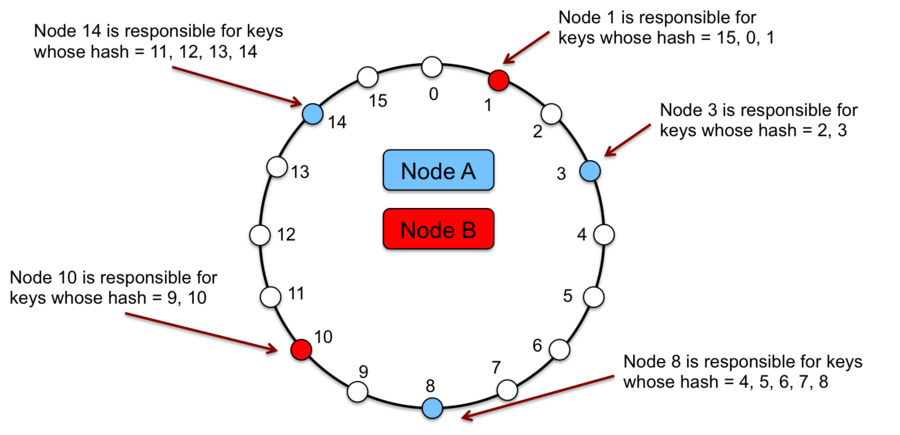一致性哈希算法 Java 实现

一致性哈希算法
In computer science, consistent hashing is a special kind of hashing such that when a hash table is resized, only n/m keys need to be remapped on average where n is the number of keys and m is the number of slots.
In contrast, in most traditional hash tables, a change in the number of array slots causes nearly all keys to be remapped because the mapping between the keys and the slots is defined by a modular operation. Consistent hashing is a particular case of rendezvous hashing, which has a conceptually simpler algorithm, and was first described in 1996. Consistent hashing first appeared in 1997, and uses a different algorithm.
程序员小灰的微信公众号里面找到了一篇 https://mp.weixin.qq.com/s/yimfkNYF_tIJJqUIzV7TFA
看了漫画算法,大概了解一致性哈希的意思,但是没有看到代码,总是觉得意犹未尽。
又去看了朱双印的《白话解析:一致性哈希算法》,同样推荐。
有心学习,无力编码
抄作业,代码来源:https://github.com/Jaskey/ConsistentHash
// Represent a node which should be mapped to a hash ringpublic interface Node { // return the key which will used for hash mapping String getKey();}
public class VirtualNode<T extends Node> implements Node { final T physicalNode; final int replicaIndex;
public VirtualNode(T physicalNode, int replicaIndex) { this.replicaIndex = replicaIndex; this.physicalNode = physicalNode; }
@Override public String getKey() { return physicalNode.getKey() + "-" + replicaIndex; }
public boolean isVirtualNodeOf(T pNode) { return physicalNode.getKey().equals(pNode.getKey()); }
public T getPhysicalNode() { return physicalNode; }}
// Hash String to long valuepublic interface HashFunction { long hash(String key);}
import java.security.MessageDigest;import java.security.NoSuchAlgorithmException;import java.util.Arrays;import java.util.Collection;import java.util.Iterator;import java.util.SortedMap;import java.util.TreeMap;
// To hash Node objects to a hash ring with a certain amount of// virtual node.// Method routeNode will return a Node instance which the object// key should be allocated to according to consistent hash algorithmpublic class ConsistentHashRouter<T extends Node> { private final SortedMap<Long, VirtualNode<T>> ring = new TreeMap<>(); private final HashFunction hashFunction;
/** * * @param pNodes collections of physical nodes * @param vNodeCount amounts of virtual nodes * @param hashFunction hash Function to hash Node instances */ public ConsistentHashRouter(Collection<T> pNodes, int vNodeCount, HashFunction hashFunction) { if (hashFunction == null) { throw new NullPointerException("Hash Function is null"); } this.hashFunction = hashFunction; if (pNodes != null) { for (T pNode : pNodes) { addNode(pNode, vNodeCount); } } }
// public ConsistentHashRouter(Collection<T> pNodes, int vNodeCount) {// this(pNodes, vNodeCount, new MD5Hash());// }
/** * add physical node to the hash ring with some virtual nodes * @param pNode physical node needs added to hash ring * @param vNodeCount the number of virtual node of the physical * node. Value should be greater than or equals 0 * */ public void addNode(T pNode, int vNodeCount) { if (vNodeCount < 0) { throw new IllegalArgumentException("illegal virtual " + "node counts :" + vNodeCount); }
int existingReplicas = getExistingReplicas(pNode); for (int i = 0; i < vNodeCount; i++) { VirtualNode<T> vNode = new VirtualNode<>(pNode, i + existingReplicas); ring.put(hashFunction.hash(vNode.getKey()), vNode); } }
/** * remove the physical node from the hash ring * @param pNode physical node */ public void removeNode(T pNode) { Iterator<Long> it = ring.keySet().iterator(); while (it.hasNext()) { Long key = it.next(); VirtualNode<T> virtualNode = ring.get(key); if (virtualNode.isVirtualNodeOf(pNode)) { it.remove(); } } }
/** * with a specified key, route the nearest Node instance in the * current hash ring * @param objectKey the object key to find a nearest Node * @return */ public T routeNode(String objectKey) { if (ring.isEmpty()) { return null; } Long hashVal = hashFunction.hash(objectKey); SortedMap<Long, VirtualNode<T>> tailMap = ring.tailMap(hashVal); Long nodeHashVal = !tailMap.isEmpty() ? tailMap.firstKey() : ring.firstKey(); return ring.get(nodeHashVal).getPhysicalNode(); }
public int getExistingReplicas(T pNode) { int replicas = 0; for (VirtualNode<T> vNode : ring.values()) { if (vNode.isVirtualNodeOf(pNode)) { replicas++; } } return replicas; }
private class MD5Hash implements HashFunction { MessageDigest instance;
public MD5Hash() { try { instance = MessageDigest.getInstance("MD5"); } catch (NoSuchAlgorithmException e) {
} }
@Override public long hash(String key) { instance.reset(); instance.update(key.getBytes()); byte[] digest = instance.digest();
long h = 0; for (int i = 0; i < 4; i++) { h <<= 8; h |= ((int) digest[i]) & 0xFF; } return h; } }}
import java.util.Arrays;
public class MyServiceNode implements Node { private final String idc; private final String ip; private final int port;
public MyServiceNode(String idc, String ip, int port) { this.idc = idc; this.ip = ip; this.port = port; }
@Override public String getKey() { return idc + "-" + ip + ":" + port; }
@Override public String toString() { return getKey(); }
private static void goRoute(ConsistentHashRouter<MyServiceNode> consistentHashRouter, String... requestIps) { for (String requestIp : requestIps) { System.out.println(requestIp + " is route to " + consistentHashRouter.routeNode(requestIp)); } }
public static void main(String[] args) { MyServiceNode node1 = new MyServiceNode("IDC1", "127.0.0.1", 8080); MyServiceNode node2 = new MyServiceNode("IDC1", "127.0.0.1", 8081); MyServiceNode node3 = new MyServiceNode("IDC1", "127.0.0.1", 8082); MyServiceNode node4 = new MyServiceNode("IDC1", "127.0.0.1", 8083);
ConsistentHashRouter<MyServiceNode> consistentHashRouter = new ConsistentHashRouter<>(Arrays.asList(node1, node2, node3, node4), 10);
String requestIP1 = "192.168.0.1"; String requestIP2 = "192.168.0.2"; String requestIP3 = "192.168.0.3"; String requestIP4 = "192.168.0.4"; String requestIP5 = "192.168.0.5";
goRoute(consistentHashRouter, requestIP1, requestIP2, requestIP3, requestIP4, requestIP5);
// new node online MyServiceNode node5 = new MyServiceNode("IDC2", "127.0.0.1", 8080); System.out.println("------puting new node online" + node5.getKey() + "------"); consistentHashRouter.addNode(node5, 10);
goRoute(consistentHashRouter, requestIP1, requestIP2, requestIP3, requestIP4, requestIP5);
System.out.println("------remove node online" + node3.getKey() + "------"); consistentHashRouter.removeNode(node3);
goRoute(consistentHashRouter, requestIP1, requestIP2, requestIP3, requestIP4, requestIP5); }}
版权声明: 本文为 InfoQ 作者【escray】的原创文章。
原文链接:【http://xie.infoq.cn/article/de862db48382a9afa624f8686】。
本文遵守【CC-BY 4.0】协议,转载请保留原文出处及本版权声明。
escray
Let's Go 2017.11.19 加入
在学 Elasticsearch 的项目经理












评论